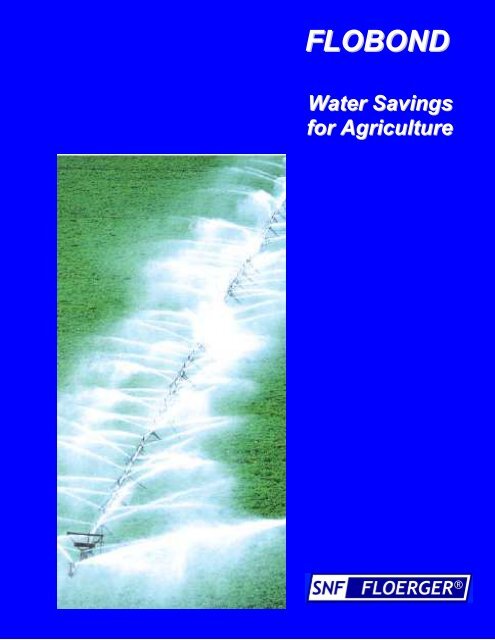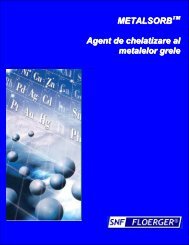FLOBOND - Products saving water agr - floerger.ro
FLOBOND - Products saving water agr - floerger.ro
FLOBOND - Products saving water agr - floerger.ro
Create successful ePaper yourself
Turn your PDF publications into a flip-book with our unique Google optimized e-Paper software.
<st<strong>ro</strong>ng>FLOBOND</st<strong>ro</strong>ng><br />
Water Savings<br />
for Agriculture
Agriculture is the prime user of <st<strong>ro</strong>ng>water</st<strong>ro</strong>ng> on the planet. 70% of the world’s available soft<br />
<st<strong>ro</strong>ng>water</st<strong>ro</strong>ng> is used for irrigation. F<strong>ro</strong>m the 3 600 km 3 of <st<strong>ro</strong>ng>water</st<strong>ro</strong>ng> extracted each year, <strong>ro</strong>ughly<br />
two thirds are consumed by evaporation, plant sweating as well as by runoff and<br />
g<strong>ro</strong>und infiltration without any use for the plants.<br />
Agriculture has already implemented<br />
many changes in order to use less <st<strong>ro</strong>ng>water</st<strong>ro</strong>ng><br />
and preserve this endangered resource.<br />
Among these techniques the use of<br />
polyacrylamides in irrigation allows to<br />
save up to 30% <st<strong>ro</strong>ng>water</st<strong>ro</strong>ng>.<br />
<st<strong>ro</strong>ng>FLOBOND</st<strong>ro</strong>ng> COMPOSITION Soil Conditioner<br />
<st<strong>ro</strong>ng>FLOBOND</st<strong>ro</strong>ng> TM is a range of organic soil<br />
conditioners based on polyacrylamide<br />
(PAM).<br />
These are <st<strong>ro</strong>ng>water</st<strong>ro</strong>ng> soluble anionic polymers<br />
of high molecular mass. Their<br />
characteristics : high molecular weight,<br />
anionic and <st<strong>ro</strong>ng>water</st<strong>ro</strong>ng>-soluble makes them<br />
very efficient as soil conditioners.<br />
<st<strong>ro</strong>ng>FLOBOND</st<strong>ro</strong>ng> TM p<strong>ro</strong>ducts make it possible<br />
to reduce the soil e<strong>ro</strong>sion caused by<br />
surface <st<strong>ro</strong>ng>water</st<strong>ro</strong>ng> runoff and to enhance the<br />
permeability of the soil.<br />
MOD DE ACTIUNE A few D<strong>ro</strong>ps is Enough<br />
<st<strong>ro</strong>ng>FLOBOND</st<strong>ro</strong>ng> TM enables the agglomeration of the fine<br />
particles of soil, which would otherwise be carried away<br />
by surface <st<strong>ro</strong>ng>water</st<strong>ro</strong>ng> runoff.<br />
When the PAM dissolves in <st<strong>ro</strong>ng>water</st<strong>ro</strong>ng>, dissociation of the<br />
potassium ion exposes a negative site on the molecule<br />
at which the colloidal soil particles will be attached (the<br />
ratio n/m ranges f<strong>ro</strong>m 0 to 100 and indicates the<br />
anionicity of the PAM).<br />
Depending on the type of soil and the method of<br />
irrigation, <st<strong>ro</strong>ng>FLOBOND</st<strong>ro</strong>ng> TM increases the amount of <st<strong>ro</strong>ng>water</st<strong>ro</strong>ng><br />
available to the <strong>ro</strong>ots while lowering the overall<br />
consumption of <st<strong>ro</strong>ng>water</st<strong>ro</strong>ng> needed for irrigation.<br />
69%Agriculture<br />
21%Industries<br />
10%Municipalities<br />
Water runoff, e<strong>ro</strong>sion and<br />
lixiviation are st<strong>ro</strong>ngly reduced,<br />
increasing <st<strong>ro</strong>ng>saving</st<strong>ro</strong>ng>s in completion<br />
p<strong>ro</strong>ducts such as fertilizers and<br />
other <st<strong>ro</strong>ng>agr</st<strong>ro</strong>ng>icultural additives.<br />
Water +<br />
<st<strong>ro</strong>ng>FLOBOND</st<strong>ro</strong>ng><br />
<st<strong>ro</strong>ng>FLOBOND</st<strong>ro</strong>ng> keeps <st<strong>ro</strong>ng>water</st<strong>ro</strong>ng> near<br />
the <strong>ro</strong>ots
USAGE<br />
All p<strong>ro</strong>ducts in the <st<strong>ro</strong>ng>FLOBOND</st<strong>ro</strong>ng> TM range are<br />
of very high viscosity in <st<strong>ro</strong>ng>water</st<strong>ro</strong>ng>. Simple<br />
injection in the <st<strong>ro</strong>ng>water</st<strong>ro</strong>ng> flow or slow dilution of<br />
tablets allows just a few mg/l <st<strong>ro</strong>ng>FLOBOND</st<strong>ro</strong>ng> TM<br />
to viscosify the <st<strong>ro</strong>ng>water</st<strong>ro</strong>ng>.<br />
It will then form aggregates of fine particles<br />
on the soil’s upper level where <strong>ro</strong>ots are<br />
formed. These aggregates will change the<br />
soil’s po<strong>ro</strong>sity and enhance the <st<strong>ro</strong>ng>water</st<strong>ro</strong>ng><br />
retention.<br />
Slowly pour the p<strong>ro</strong>duct into the irrigation <st<strong>ro</strong>ng>water</st<strong>ro</strong>ng>. Gentle stirring prevents the particles<br />
agglomerating. The greater the temperature of the <st<strong>ro</strong>ng>water</st<strong>ro</strong>ng>, the faster the p<strong>ro</strong>duct will dissolve.<br />
Pressurise the system before injection. A non-return valve is requiered on the injection<br />
system.<br />
If the p<strong>ro</strong>duct is spilt, pick up the p<strong>ro</strong>duct with a shovel or by suction. After cleaning, flush<br />
away any traces with <st<strong>ro</strong>ng>water</st<strong>ro</strong>ng>.<br />
To clean equipment, blow away powder traces with compressed air.<br />
Avoid contact with thw skin and eyes (the use of gloves and goggles is recommended). For<br />
powders it is recommended to wear an anti-dust mask.<br />
For further information, consult the Material Safety Data Sheets (MSDS).<br />
IMPLEMENTATION Powders, Emulsions or Tablets<br />
<st<strong>ro</strong>ng>FLOBOND</st<strong>ro</strong>ng> TM exists in different forms, powder, emulsion and tablets. For every existing<br />
irrigation system, SNF has the most efficient, safe and simple application equipment.<br />
RESULTS Save up to 30% Water<br />
Under most irrigation conditions a third of the <st<strong>ro</strong>ng>water</st<strong>ro</strong>ng> loss is due to <st<strong>ro</strong>ng>water</st<strong>ro</strong>ng> run-off and lixiviation.<br />
Nume<strong>ro</strong>us independent studies and full-field tests using polyacrylamides, mainly in Australia<br />
and the USA, have demonstrated that the same p<strong>ro</strong>duction is reached while irrigating less<br />
frequently and using less <st<strong>ro</strong>ng>water</st<strong>ro</strong>ng> each time. <st<strong>ro</strong>ng>FLOBOND</st<strong>ro</strong>ng> TM also lowers the losses by lixiviation<br />
of nutritional elements ; these will be stored in the <strong>ro</strong>oting zone before being used by the<br />
plants.
Soil losses (kg/ha)<br />
Infiltration rate (mm/h)<br />
Soil losses by irrigation as a function of<br />
terrain slope<br />
Cont<strong>ro</strong>l<br />
PAM 8 ppm<br />
Average slope (%)<br />
Rate of infiltration of loamy soil, as a function of<br />
cumulative rainfall<br />
Cont<strong>ro</strong>l<br />
PAM 5 kg/ha<br />
PAM 10 kg/ha<br />
Cumulative rainfall (mm)
Concentration (ppb)<br />
Concentration of various pesticides<br />
in the runoff <st<strong>ro</strong>ng>water</st<strong>ro</strong>ng> at the field outlet<br />
Cont<strong>ro</strong>l<br />
PAM 1,5 kg/ha<br />
EPTC trifluralin terbufos<br />
EPTC = S-Ethyl Dip<strong>ro</strong>pylcarbamothioate (C9H19NOS)<br />
Emergence (plants/ha)<br />
Emergence of beet plants f<strong>ro</strong>m<br />
a soil sensitive to crusting<br />
Cont<strong>ro</strong>l<br />
PAM 2 kg/ha<br />
Lime milk 230 l / ha<br />
Day 9 Day 28
ADVANTAGES<br />
<st<strong>ro</strong>ng>FLOBOND</st<strong>ro</strong>ng> TM increases the cohesion of poorly structured soils, so that less sediment is<br />
entrained by <st<strong>ro</strong>ng>water</st<strong>ro</strong>ng> runoff. The result : an average reduction of 95% in e<strong>ro</strong>sion.<br />
The po<strong>ro</strong>sity of the soil is also conserved, so maintaining excellent infiltration of the soil by<br />
<st<strong>ro</strong>ng>water</st<strong>ro</strong>ng> (+35% on clay-loam soils to +50% on clay soils).<br />
<st<strong>ro</strong>ng>FLOBOND</st<strong>ro</strong>ng> TM also considerably reduces the leaching of nutrients (e.g. : 84% less for<br />
phosphates and nitrates) and pesticides in the runoff <st<strong>ro</strong>ng>water</st<strong>ro</strong>ng>s (e.g. atrazine, trifluralin).<br />
<st<strong>ro</strong>ng>FLOBOND</st<strong>ro</strong>ng> TM brings about an imp<strong>ro</strong>vement in germination rate by up to 35% for plants<br />
sensitive to soil crusting (e.g. : beet and vegetable c<strong>ro</strong>ps).<br />
ENVIRONMENT Low Impact<br />
<st<strong>ro</strong>ng>FLOBOND</st<strong>ro</strong>ng> TM naturally breaks down in soils under the action of UV radiations and<br />
mic<strong>ro</strong>biological attacks to form <st<strong>ro</strong>ng>water</st<strong>ro</strong>ng>, CO2 and ammonium nitrate. Soil bacteria consume the<br />
nit<strong>ro</strong>gen g<strong>ro</strong>up of the molecule rapidly. The carbon g<strong>ro</strong>up breaks down by app<strong>ro</strong>ximately 10 –<br />
15 % per annum depending on UV intensity.<br />
The concentration of the p<strong>ro</strong>duct in the runoff <st<strong>ro</strong>ng>water</st<strong>ro</strong>ng>s is ze<strong>ro</strong> 30 minutes after the end of<br />
application.<br />
The duration of field efficacy of <st<strong>ro</strong>ng>FLOBOND</st<strong>ro</strong>ng> TM varies f<strong>ro</strong>m 4 to 8 weeks, depending on the<br />
<st<strong>ro</strong>ng>agr</st<strong>ro</strong>ng>o-climatic conditions.<br />
No toxicity has been found in <st<strong>ro</strong>ng>water</st<strong>ro</strong>ng> or soil. The p<strong>ro</strong>duct is app<strong>ro</strong>ved in the USA (US FDA =<br />
Food & Drugs Administration) and in France (Le Ministere de la sante = French Ministry<br />
of Health) as a drinking <st<strong>ro</strong>ng>water</st<strong>ro</strong>ng> and waste<st<strong>ro</strong>ng>water</st<strong>ro</strong>ng> treatment additive.
SNF S.A.<br />
Zac de Milieux, 42163, Andrezieux Cedex,<br />
France<br />
Telefon : +33 (0)4 77 36 86 00<br />
Fax: +33 (0)4 77 36 86 00<br />
E-mail : info@snf.fr<br />
www.snf-g<strong>ro</strong>up.com<br />
Flochem Romania<br />
Str. Mihail Cioranu 4, sector 5, Bucuresti<br />
Telefon : 021 410 78 09<br />
0744 567 466<br />
0744 425 079<br />
Fax : 021 410 30 26<br />
E-mail : flochem@<st<strong>ro</strong>ng>floerger</st<strong>ro</strong>ng>.<strong>ro</strong><br />
office@snf.<strong>ro</strong><br />
www.snf.<strong>ro</strong>



